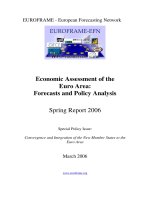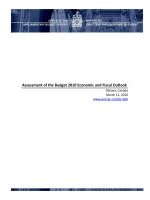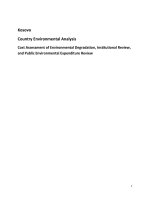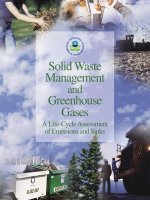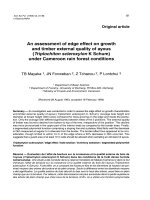ASSESSMENT OF STATUS MEDICAL WASTE MANAGEMENT AND TREATMENTIN TUYEN QUANG GENERAL HOSPITAL
Bạn đang xem bản rút gọn của tài liệu. Xem và tải ngay bản đầy đủ của tài liệu tại đây (1.67 MB, 67 trang )
THAI NGUYEN UNIVERSITY
UNIVERSITY OF AGRICULTURE AND FORESTRY
VU LAN TRANG
TOPIC TITLE:
ASSESSMENT OF STATUS MEDICAL WASTE MANAGEMENT
AND TREATMENTIN TUYEN QUANG GENERAL HOSPITAL
BACHELOR THESIS
Study Mode : Full- time
Major
: Bachelor in Environmental Science and Management
Faculty
: International Training and Development Center
Batch
: K42- Advance Education Program
Thai Nguyen, 23/ 01/2015
i
Thai Nguyen University of Agriculture and Forestry
Degree Program
Bachelor of Environmental Sciences and Management
Student Name
Vu Lan Trang
Student ID
DTN1053100118
Thesis Title
Assessment of status medical waste management and
treatment in Tuyen Quang General Hospital
Supervisor
Dr. Nguyen Hung Quang
Abstract:
Assessment and analyze the status of medical waste management in Tuyen
Quang General Hospital: Assess the classification, transportation, storage and
treatment of medical waste and wastewater generated in operation process of Tuyen
Quang General Hospital. Analyze and propose solutions: Causing of existence in the
management and treatment of medical waste in hospital. Solutions to improve the
management efficiency and treatment medical waste: Treating waste to improve the
efficiency for medical waste management in Tuyen Quang General Hospital.
Keywords
Medical
waste;
Hazardous
medical
waste;
waste
management; wastewater treatment system; Tuyen Quang;
Number of pages
59
Date of submission
23/01/2015
ii
ACKNOWLEDGMENT
With the consent of the Managing Board - Thai Nguyen University of
Agriculture and Forestry, International Training and Development Center, the
assistance and guidance of Dr. Nguyen Hung Quang. I conduct research with topic:
"Assessment of status medical waste management and treatment in Tuyen Quang
General Hospital"
In order to complete this thesis, firstly I would like to sincerely thank the
managing board of Thai Nguyen University of Agriculture and Forestry, International
Training and Development Center, thank teachers, who imparted to me the knowledge
and skills during the time I study and practice at Thai Nguyen University of
Agriculture and Forestry.
Especially, I would like to sincerely thank the enthusiastic help of Dr. Nguyen
Hung Quang who guided me during the time of graduation exercises to
implementation and complete this thesis.
I would like to thank the assistance of staffs who are working at Department of
Natural Resources and Environment of Tuyen Quang province, Environmental Protection
Agency has helped me during internships time, impart practical experience for me. I
would like to thank staff and officers at Tuyen Quang General Hospital who created the
best conditions for me to completed this thesis.
This is the first time I've implementation a thesis, due to knowledge of myself
and the time are limited, certainly in my thesis was shortcomings and restrictions. I
hope to receive feedback, comments and additions to my thesis complete and found
the exist shortcomings of myself.
I would like to sincerely thank!
Tuyen Quang, 23 rd January, 2015
Student
Vũ Lan Trang
iii
TABLE OF CONTENTS
LIST OF FIGURES.................................................................................................. 1
LIST OF TABLES.................................................................................................... 2
LIST OF ABBREVIATIONS................................................................................... 3
PART I. INTRODUCTION ..................................................................................... 4
1.1. Research rationale ....................................................................................... 4
1.2. Research’s objectives .................................................................................. 5
1.3. Research questions and hypotheses.............................................................. 5
1.4. Limitations .................................................................................................. 6
1.5. Definitions................................................................................................... 6
PART II.LITERATURE REVIEW ......................................................................... 8
2.1. Scientific base of the study .......................................................................... 8
2.2. Theoretical base of the study ....................................................................... 9
2.2.1. Classification of the medical waste........................................................... 9
2.2.2. Harmful effects of medical waste............................................................ 11
2.3. Current status of medical waste management in Vietnam .......................... 14
2.3.1. General situation..................................................................................... 14
2.3.2. The process of collecting, sorting and transporting waste in the health care
facilities .................................................................................................................... 18
2.3.3. Measures and technologies to treat hazardous medical waste.................. 19
PART III. METHODS ........................................................................................... 22
3.1. Material..................................................................................................... 22
3.2. Methods .................................................................................................... 23
3.3.1. Interview methodology in the field ......................................................... 23
3.3.2 Methods of analysis, synthesis document................................................. 23
3.2.3 The sampling method of wastewater........................................................ 24
3.2.4. Experimental and analysis methods in the laboratory.............................. 24
PART IV. RESULTS.............................................................................................. 26
4.1. The overview of Tuyen Quang General Hospital ....................................... 26
4.1.1. Functions and tasks................................................................................. 27
iv
4.2. Sources of waste and the methods to collect, classify and treat medical waste
in Tuyen Quang General Hospital............................................................................. 30
4.2.1. Common Solid Waste ............................................................................. 30
4.2.3. Hazardous waste..................................................................................... 32
4.2.3 .Wastewater............................................................................................. 35
4.2.3. Gas emission .......................................................................................... 40
4.3. Assessment the preliminary way of medical waste .................................... 47
4.3.1. Domestic waste ...................................................................................... 47
4.3.2. Hazardous medical waste........................................................................ 48
4.3.3. Wastewater............................................................................................. 49
4.4. Assessment the quality of wastewater in Tuyen Quang General Hospital .. 50
4.4.1. Sources of wastewater ............................................................................ 50
4.4.2. Result of observational, analysis............................................................. 51
4.5. Recommendation some solutions for collection and treatment activities of
medical waste in Tuyen Quang General Hospital...................................................... 53
4.5.1 Solution in the collection, storage and treatment of medical waste........... 53
4.5.2. Solutions for wastewater treatment system ............................................. 54
4.5.3. Management mission.............................................................................. 54
PART V. DISCUSSION AND CONCLUSION..................................................... 56
5.1. Discussion ................................................................................................. 56
5.1.1. Area and position of Tuyen Quang General Hospital .............................. 56
5.1.2. Status of waste management and treatment in hospital............................ 56
5.1.3. Results of the environmental research..................................................... 57
5.2. Conclusion ................................................................................................ 58
REFERENCES ....................................................................................................... 60
v
LIST OF FIGURES
Figure 4.1.Organization chart of Tuyen Quang General Hospital.............................29
Figure 4.2. Hazardous medical waste generating trendy in 2013-2014 .....................34
Figure 4.3. Treatment technology of wastewater......................................................37
Figure 4.4. Preliminary way of domestic waste........................................................48
Figure 4.5. Preliminary way of Hazardous medical waste ........................................49
Figure 4.6. Preliminary way of wastewater ..............................................................50
1
LIST OF TABLES
Table2.1. Some examples of infection due to contact with medical waste.
Microorganism category of pathogenic and procedure infection. ...............................12
Table 2.2.Waste arising under the beds in Vietnam in 2012 .......................................15
Table 2.3. Distribution of medical waste by type of urban .........................................16
Table 2.4. Comparison of medical waste generated in Vietnam with some neighboring
countries in 2012 .......................................................................................................17
Table 3.1. Notation of sampling locations..................................................................22
Table 4.1. List of hazardous waste generated an average of 01 month .......................32
at Tuyen Quang General Hospital ..............................................................................32
Table 4.2. Reality amount of hazardous medical waste in Tuyen Quang General
Hospitals....................................................................................................................33
Table 4.3. Time existence of some microorganisms ...................................................42
Table 4.4. Results of the wastewater target analysis of Tuyen Quang General Hospital .......51
2
LIST OF ABBREVIATIONS
BOD5
The biochemical oxygen demand in 5 days.
COD
Chemical oxygen demand
MONRE
Ministry of Natural Resources and Environment
MOH
Ministry of Health
MOC
Ministry of Construction
One member co., Ltd
One Member Limited Liability Company
3
PART I. INTRODUCTION
1.1. Research rationale
Caring, protecting and improving human's health is an important task of the
health sector. In order to adequately meet for medical examination and treatment and
health care demand of people, received the attention of the Party and State, medical
facility system have been continuously enhanced, expanded and improved. However,
during operation process, the health system, especially the hospital has discharged a
large amount of medical waste substances, including hazardous medical waste.
According to the World Health Organization (WHO, 1994), the components of
medical waste about 10% of the infection waste and 5% is noxious waste such as
radioactive, cytotoxic substances, toxic substances generated in the diagnosis and
treatment procedure. It is risk factors of environmental pollution, pathogens spread
from hospital to surroundings area, lead to increased risk of monomial infection and
increased disease incidence of local communities living in contiguous areas.
In order to assess the status of medical waste as well as the impact of medical
waste on the environment, they need to have research of the scientists and agencies.
Research has been showing that existed in the medical waste management in our
country. However currently, for many reasons, including the pressure on the need of
medical examination and treatment of people, the overload of many hospitals, lack of
uniformity in infrastructure of the hospital means environmental sanitation of many
hospitals is not guaranteed.
Tuyen Quang General Hospital is the provincial hospital. It is the medical
examination and treatment center of Tuyen Quang province. The scale of hospital is
4
500 beds, with all the Department of Internal Medicine, Department of Surgery and
Clinical Departments. The number of patients examined on average is between 400500 cases/ day. The rate of bed occupancy often exceeds 100%. The hospital is located
in the city center where it is the largest concentration of population so that the
shortcomings in the management and treatment of medical waste will greatly affect to
surrounding communities.
Stemming from the above problems I conducted research topics “Assessment of
status medical waste management and treatment in Tuyen Quang General
Hospital”.
1.2. Research’s objectives
- Cursory review of Tuyen Quang General Hospital.
- Assessment of status medical waste management and treatment in Tuyen
Quang General Hospital.
- Propose solutions to increase the effect of medical waste management and
reduce pollution.
1.3. Research questions and hypotheses
- What is the current situation of medical waste management in Tuyen Quang
General Hospital?
- What is the way to treatment medical waste of Tuyen Quang General
Hospital?
- How do we can closely management the medical waste of Tuyen Quang
General Hospital?
5
1.4. Limitations
The time is limited; I have only 4 months for research. So I choose this matter
in Tuyen Quang General Hospital to assess the status of management and treatment
mission.
Due to Tuyen Quang General Hospital located in convenient area with the high
population density and big scale of hospital so the assessment activities has limit.
1.5. Definitions
According to MONRE (2007), there are some definitions which are use in the
research:
- Medical waste is all waste materials generated at health care facilities, such as
hospitals, clinics, physician's offices, dental practices, blood banks, and veterinary
hospitals/clinics, as well as medical research facilities and laboratories.
- Hazardous waste is waste that is dangerous or potentially harmful to our
health or the environment. Hazardous wastes can be liquids, solids, gases, or sludges.
They can be discarded commercial products, like cleaning fluids or pesticides, or the
by-products of manufacturing processes.
- Hazardous medical waste management is controlled waste activities during
the process from waste generation to initial treatment, collection, transport, storage and
disposal of hazardous medical waste.
- Collecting is the separation, classification, collection, packing and temporary
storage of waste at the central location of medical facility.
6
- Transportation is the process of transporting waste from the place generated
to place of initial treatment, storage and treatment.
- Preliminary treatment is the disinfection or sterilizing process of waste which
have high risk of infection near place waste generated before transportation to store or
destroy.
- Handling and treatment is the process of using the technology in order to lose
potentially of hazardous waste on human’s health and environment.
- Re-use is use a product several times until the end the life of products or use
products under a new function or purpose.
-Recycle is reproduction of discarded materials to a new product.
7
PART II. LITERATURE REVIEW
2.1. Scientific base of the study
- Protection environment of Vietnam Law, 2005;
- Decide No.22/2006/Decide – MONRE dated December 18th , 2006 Ministry
of Natural Resources and Environment about compel application Vietnam
environment standard;
- Decree No. 59/2007/ Decree – Government dated April 09th , 2007 the
Government of Socialist Republic of Vietnam about solid waste management;
- Circular No.13/2007/Circular - MOC dated December 31st , 2007 the Ministry
of Construction issued guidance some articles of Decree No.59/2007/Decree-The
Government dated April 09th , 2007 the Government of Socialist Republic of Vietnam
about solid waste management;
- Decide No. 43/2007/Decide – MOH dated November 30th, 2007 Ministry of
Health promulgate Regulations about medical waste management;
- Circular No.16/2009/Circular - MONRE dated October 7th, 2009 of the
Ministry of Natural Resources and Environmental - Regulations on National technical
regulations on the environment;
- Circular No.12/2011/Circulars - MONRE dated April 14th, 2011 Ministry of
Natural Resources and Environment about hazardous waste management.
- Circular No.31/2013/ Circular - MOH dated October 15th, 2013 of the
Ministry of Health - Regulations about environmental impact observation from
examination and treatment activities of the hospital.
8
2.2. Theoretical base of the study
2.2.1. Classification of the medical waste
According to MONRE (2007), Medical wastes are classified into the following
categories:
Infectious waste:
- Acuity waste (category A): this type of wastes can cause cuts or puncture,
bacterial infections including: needles and syringes, surgical knife blade, saws, broken
glass pieces and other sharp items used in medical activities.
- Un-sharp infection waste (category B): waste being soaked in blood or
biological fluids of the body and generated from the isolation disease prevention.
- Wastes with high risk of infection (category C): waste generated in
laboratories such as specimens and other utensils thoroughly.
- Waste from surgery (category D): including the tissues, organs, body parts,
placentas and laboratory animal carcasses.
Hazardous chemical waste:
Chemical and pharmaceutical waste generated from the tests, diagnosis
activities includes: formaldehyde, photo-resist chemicals, solvents, ethylene, and
mixture of chemicals.
Radioactive waste:
Including solid, liquid and gas radioactive waste generated from the diagnosis,
treatment, research and production activities.
Radioactive waste including:
9
- Solid radioactive waste includes materials to be used in the laboratory,
diagnosis, treatment, such as syringes, needles, safety goggles, waterproof paper,
antiseptic swabs, test tubes, bottles of radioactive substances.
- Liquid radioactive waste includes a solution containing radionuclide generated
during the diagnosis as the patient's urine, ejector, and water washing of appliances
containing radioactive substances.
- Radioactive gases including gas used in 133C clinical, the gas escapes from
storage of radioactive materials.
Pressure tank
It is including oxygen, CO2, gas tanks. These cylinders are inflammable or
explosive when burned.
Ordinary waste
Ordinary waste does not typically contain infectious elements, hazardous
chemical, radioactive, flammable, explosion including:
- Domestic waste generated from the patients' rooms (except the isolation
patients' rooms).
- Waste generated from the activities of a medical professional such as glass
bottles, serum bottles, plastic materials, powders to bunch for broken bones. These
wastes not contaminated with blood, biological fluids and hazardous chemicals.
- Waste generated from administrative work: newspapers, documents,
packaging materials, plastic bags.
- Surroundings waste: leaves and rubbish from the surrounding areas.
10
2.2.2. Harmful effects of medical waste
In accordance with the older literature such as Jenny (2000), medical waste if
not be well treatment, when it discharge into the environment may affect to human
health, cause major epidemics in the community.
a. People who are at high risk:
People who are at risk of disease due to medical waste are those who have regular
personal contact with them. They are usually located in the following groups:
- Doctors, nurses, health care personnel and hospital staffs.
- Patients of the hospital or health care center.
- Guests or family member of hospital or health care center.
- Staff in the hospital, support services and health care centers such as laundry,
transportation and waste treatment.
- Employees working in the waste management facilities such as waste
incinerators.
b. Harmful effects of infectious waste and acuity waste
With the diseases have infectious potentially, dangerous caused by virus like
HIV/AIDS, hepatitis B or C, medical staff, especially nurses, orderlies who have the
highest risk of infection through wounds caused by sharp objects contaminated blood
of patients.
The rate of lesions caused by sharp objects in medical waste and sanitation
services within and outside the hospital causing has been registered with agency of
toxins and diseases United States (ATSDR) assessment. Many lesions caused by
11
needles before throw into the container, so the metal container is not closed or made of
materials that easily torn or pierced ( LaGrega, 2010).
Table2.1. Some examples of infection due to contact with medical waste.
Microorganism category of pathogenic and procedure infection.
Infectious category
Gastric infectious
Breath infectious
Eyes infectious
Genital infectious
Skin infectious
Microorganism pathogenic
Enterobacteria group:
salmonella, shigella spp,
vibrio cholerac, parasitic
worms.
Tuberculosis bacterium,
rubeola virus ,streptococcus
pneumoniac
Virus herpes
Neiserreria gonorrhoeac,
virus herpes
Streptococcus spp
Bacillus antharacis
Anthrax
Meningitis
AIDS
Petechial fever
Blood infectious by
congestion
Meningococcal ( Neisseria
meningitides)
HIV
Virus: junin, lassa, ebola,
marburg
Staphylococcus spp
Form of medical
waste
Feces or vomit
Juice from human body
and sputum.
Eyes juice
Genital juice
Pus
Secretion from skin
(perspiration, egesta)
Encephalospinal juice
Blood, genital secretion.
All produce of blood và
secretion
Blood
Candida fungus
Group of congestion
bacterium (Staphylococcus
spp , anti- coagulate :
Staphylococcus arueus);
enterococcus; enterbacter;
klebssiella; Streptococcus
spp
Candida albican
Hepatitis A
Hepatitis A virus
Feces
Hepatitis B, C
Hepatitis B, C virus
Blood, body juice
Blood infectious by
different category of
bacteriums
Blood
Blood
( Prüss, 1999)
12
c. Harmful effects of chemical waste and pharmaceutical
Many chemicals and pharmaceuticals used in health care facilities are the risk to
human’s health such as the poisonous, the toxic gene, cell poisons, corrosives, reaction
substances, explosion, anaphylactic shock. It is frequently occupied a small amount of
medical substances or sometimes with a high rate but in the form of drugs, biological are
overdue, drug redundant or wears off should discard.
It caused poisoning by acute exposure and chronic poisoning, caused damage
such as burns. The contamination may be the result of absorption of chemicals or
pharmaceuticals through skin, mucous membrane, through the respiratory tract or
gastrointestinal tract.
Exposing with flammable substances, corrosive substances, reactive substances
(formaldehyde) and other volatile substances can cause damage to skin, eyes or
respiratory mucous membrane. The most common injuries are different types of burns
(Lien, 2009).
Disinfection chemical is a particularly important component of medical waste
group in chemicals form. It is often used in large quantities and usually corrosive
substances. It should also be noted that this is the kind of reactions chemical and also
can be create a secondary mixture have highly toxic.
Killing insect chemical overdue stored in the leak tank or puncture bag may be
directly or indirectly affect the health of anyone exposed to it.
The chemical products discharged directly into the sewage system can be
detrimental to the operation of the wastewater treatment systems (the most is treatment
13
system by biotechnology) or cause toxic effects to natural ecosystems receiving this
water. The same problem can also occur due to the products of preparation medicine
process including antibiotics and other drugs, heavy metals such as mercury, phenol
and derivatives, the disinfectants chemical.
d. Harmful effects of radioactive waste:
The types of diseases caused by radioactive waste determined by the type, objects
and scope of exposed. The radioactive waste as well as pharmaceutical waste is a type of
toxic effect to cell, genes, and may also affect the genetic factors. Exposure to radioactive
sources with high activity, such as the radiation source by diagnostics means such as Xray machine, CT scanner, ... can cause a variety of lesions such as destroy the tissue,
causing acute burns (with some serious cases, this can lead to the removal or amputation
of the affected body part).
e. Harmful effects of medical waste
Wastewater from the medical facility is the place "supply" of pathogenic
bacteria, especially wastewater from hospitals specializing in infectious diseases as
well as infectious department of the hospital. Wastewater is one of the basic factors
that have the potential to spread of infectious diseases through the digestive tract.
2.3. Current status of medical waste management in Vietnam
2.3.1. General situation
Currently, in Vietnam, there are 13,149 health care facilities, of which 30 health
care facilities belong to the Ministry of Health, 12,259 health care facilities belong to
provincial Department of Health and 860 other facilities (Lien, 2009). This is the
primarily source of medical waste.
14
According to the Department of Environmental Health Management, in 2010,
each day nationwide the health care facilities discharged 380 tons of solid waste. Of
these, approximately 45 tons is hazardous medical waste. Currently, the rate of
medical waste increase is about 7.6% / year. Estimates for 2020, the waste volume will
double to about 800 tons / day.
Table 2.2.Waste arising under the beds in Vietnam in 2012
Hospitals
Unit
Total of
Hazardous
medical waste
medical waste
Central Hospital
(kg/bed)
0.97
0.16
Provincial Hospital
(kg/bed)
0.88
0.14
District Hospital
(kg/bed)
0.72
0.11
Average
(kg/bed)
0.86
0.14
(Department of Environmental Management, 2012)
15
Table 2.3. Distribution of medical waste by type of urban
Type of city
Special
Provinces having 1st class
city
Provinces having 2nd class
city
Provinces having 3rd class
city
Province/City
Ha Noi
5000
Ho Chi Minh
2800
Dak Lak
276.3
Khanh Hoa
365
Lam Dong
209.3
Nam Dinh
488
Nghe An
187.6
An Giang
320.1
Ca Mau
159.5
Dong Nai
430.8
Phu Tho
126.54
Bac Lieu
134.8
Binh Duong
1241
Dien Bien
79.1
Ha Giang
405
Ha Nam
967
Hau Giang
634.8
Kien Giang
642.4
Long An
Provinces having 4th class
city
Volume of medical solid
waste (tons/year)
369
Quang Nam
602.25
Quang Tri
272.12
Soc Trang
266.7
Son La
175
Tra Vinh
400
Vinh Long
340.26
Yen Bai
108.542
(Annual report of the local, 2010)
16
In accordance with the older literature such as MONRE (2010), the amount of
wastewater generated in the health care facilities is currently around 150,00m3/day, not
mention to the amount of wastewater of Preventive Medicine institutions, the medical
institutions and drug manufacturing. The estimated amount for 2015 of medical
wastewater will increase over 300,000 m3/day.
Emission trends of medical waste:
Although the general total of medical waste discharged has not changed or just
slightly increased, but the amount of hazardous medical waste must be treated
specially to increases over time by two trends:
- Increasing use of disposable tools such as needle, pressing tongue, surgical
gloves, catheters, cotton bandage.
- Increasing the number of beds at the treatment facility from district level and
equivalent or higher.
Table 2.4. Comparison of medical waste generated in Vietnam with some
neighboring countries in 2012
Content
Vietnam
Malaysia
Thailand
Population (Million people)
88
29
67
Medical waste arises (tons/day)
27
13
33
0.16
0.2
0.19
Medical waste arises per capita/year (kg)
(Statistical data via the internet)
Comparing with other countries in ASEAN group, the amount of medical waste
generated of Vietnam at lower levels in the region.
17
The amount of medical waste tends to increase over time. It is increase in both
general medical waste and hazardous medical waste.
Meanwhile, environmental of health issues are not adequate attention.
According to statistics from the Ministry of Health (2012), currently only about 44%
hospitals have solid waste treatment system, but many places have fallen into
disrepair. Even in the central hospitals still 25% have no waste treatment system,
corresponding to 50% and 60% in provincial and district hospitals.
2.3.2. The process of collecting, sorting and transporting waste in the health care
facilities
According to Tao (2002), waste generated in the health care facilities is divided
into two categories: Domestic waste and medical waste.
Laborer has responsible for the collect domestic waste daily at the facility and
transport to gathering place of waste. Health care facilities usually cooperation with
the local urban environment company to collect and treat domestic waste.
For the medical waste with high hazard usually have method of collecting,
transporting separately. This type of waste is packed in special bags:
- Waste from the patient’s room is packed in yellow plastic bag marked biohazard symbol.
- The common of waste and cells poisonous are packed in blue plastic bags.
- Chemical wastes and radioactive substances are packed in black plastic bag
with special materials which are labeled indicating the waste resources.
All type of wastes will be treated in the incinerator.
18
2.3.3. Measures and technologies to treat hazardous medical waste.
The general requirements:
- Making hazardous medical waste harmless for human health and environment.
- Reducing the quantity.
- Meet the requirements of economy and efficiency of socio-economic cycle.
Principles for treatment of hazardous medical waste:
- None cause secondary pollution.
- Within the general provisions on the management and treatment of waste,
satisfy the environmental protection laws.
Technology of treatment and destroy:
There are many methods and technologies to treat hazardous medical waste
(Thuy, 2002). Some main technologies and solutions such as:
- Incineration technology: use of energy from the fuel to burn waste. It may be
treatment many types of waste especially clinical waste. This method can minimize the
amount and volume of waste and completely destroy the pathogens in medical waste.
This method requires the high cost for initial investment, running and maintenance
costs are relatively expensive.
- Chemical disinfection technology: Using some chemical disinfection to kill
microorganisms can make waste safe in terms of microorganisms. Chemicals usually used
include formaldehyde (HCHO); ethylene oxide (CH2O CH2); glutaraldehyde (CHO(CH2)3- CHO); Sodium Hypochlorite (NaOCl); Chlorine dioxide (ClO2). This method has
lower costs for the original investment, operating costs expensive or not depending on the
19
type of chemical, some secondary pollution can happen from the residual chemicals. The
cost used for treatment medical waste in the industrialized countries around 100-120
USD/ ton.
- Wet and dry thermal treatment technology: Using moist heat (autoclave) or
steaming dry (ovens) to kill bacteria at temperatures 121- 160oC. Almost all pathogens
are destroys at this temperature. Advantage of this method is applicable to the case of
very small quantities of waste and disadvantage of this method is poorly effective in
minimizing both volume and weight.
- Microwave irradiation technology: Microwave technology to treat hazardous
medical waste is a new technology and efficiency. The modern equipment can treat
about 250 kg/ hour approximate 3,000 tons/year. This type of microwave often used
source of electromagnetic radiation with ultra-high frequency from 2450 MHz,
wavelength around 12.24cm. The original cost is relatively expensive, but medical
waste treated by this method, many materials can reuse as raw materials for inclusion
in the economic cycle.
- Land treatment technology: This method has low costs for initial investment,
cheap operating costs, but it should only be undertaken when the authorities manage
environmental permit and natural conditions suitable such as a large area, soil
characteristics, characteristics of groundwater resources, far from residential areas.
- Inertization technology: The process of confining waste with some material such
as cement and lime. People usually mixing 65% hazardous medical waste, 15% lime, 15%
cement and 5% water. This mixture is compressed into chunks.
20
